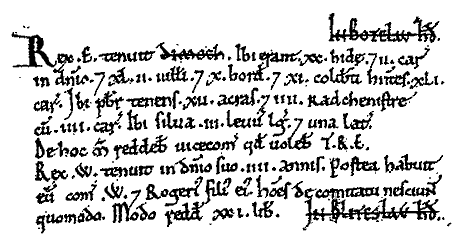 St Mary's Church, Dymock
St Mary's Church, Dymock
| Admin | |||
| . | Home | Contents | |
| H&S Policy | People Safety | Grave Yard | |
The Church & The World
Faith & Care
Faith & Care
Things Past
People & Features
People & Features
Domeday Book

We know that Dymock Church existed since at least 1085 because we have the list of Vicars from that time (see 'Vicars of Dymock)' Also, in 1066, William, Duke of Normandy invaded Britain and defeated the new king Harold, who had taken over from King Edward. The battle was known as 'The Battle of Hastings' and William became 'William the Conqueror'.
William was very organised. He wanted to know how much tax he could collect, so in 1086 he arranged a census which was recorded in two large volumes that became known as 'The Domesday Book....' and Dymock Church has an entry. (Return to top)
William was very organised. He wanted to know how much tax he could collect, so in 1086 he arranged a census which was recorded in two large volumes that became known as 'The Domesday Book....' and Dymock Church has an entry. (Return to top)
The Dymock's Entry In Domesday Book
Translation
The census was recorded in Latin using extensive abbreviations and is translated as follows:
King Edward held Dimoch in Botelau hundred. There were 20 hides(i) and 2 plow-tillages(ii) in demesne(iii), and 42 villeins(iv) and 10 borders and 11 freemen having 41 plow-tillages. There is a priest having 12 acres and 4 radchenisters(v) with 4 plow-tillages. There is a wood 3 miles long and 1 broad. The Sheriff paid what he pleased for this manor in the time of King Edward.
King William held it in his demesne 4 years.
Earl William and his son Roger had it afterwards, and the men of the county know not how. It now pays £2l.
(Return to top)
King Edward held Dimoch in Botelau hundred. There were 20 hides(i) and 2 plow-tillages(ii) in demesne(iii), and 42 villeins(iv) and 10 borders and 11 freemen having 41 plow-tillages. There is a priest having 12 acres and 4 radchenisters(v) with 4 plow-tillages. There is a wood 3 miles long and 1 broad. The Sheriff paid what he pleased for this manor in the time of King Edward.
King William held it in his demesne 4 years.
Earl William and his son Roger had it afterwards, and the men of the county know not how. It now pays £2l.
(Return to top)
Explanation
(i) Hide: about 100-200 acres, but varied considerably. Originally, land sufficient to support one family.
(ii) Plow-Tillage: about 120 acres, the work of a household and team of eight oxen.
(iii) Demesne - Land attached to a manor and retained by the owner for their own use (pronounced 'de mean').
(iv) Villein - A feudal tenant subject to a lord, to whom he paid dues and service in return for land.
(v) Radchenistri: free tenants, held their land by service on horse-back, not necessarily of a military character, but rather as a kind of honour to their superior, though no doubt they would have been required to render protection if it was needed.
(Return to top)
(ii) Plow-Tillage: about 120 acres, the work of a household and team of eight oxen.
(iii) Demesne - Land attached to a manor and retained by the owner for their own use (pronounced 'de mean').
(iv) Villein - A feudal tenant subject to a lord, to whom he paid dues and service in return for land.
(v) Radchenistri: free tenants, held their land by service on horse-back, not necessarily of a military character, but rather as a kind of honour to their superior, though no doubt they would have been required to render protection if it was needed.
(Return to top)
